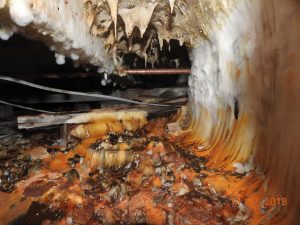Surge in dry rot cases reported in UK homes
01/11/2018

A national trade body has reported a significant number of dry rot cases in homes.
Reports of the fungal timber decay taking hold in properties from members of the Property Care Association have risen – and the trade body says a number of factors could be behind the increase.
A changing climate, different approaches to property maintenance and watertight building materials are all put forward as potentially contributing to the increase.
Steve Hodgson, chief executive of the PCA said: “Our members have reported a large number of cases of dry rot this year.
“We are looking into the reasons for this, because despite the long hot summer, the issue has continued to develop from the high figures we saw in 2017.
“Dry rot’s name can be a misnomer. It needs moisture content in excess of 20 per cent before it will develop, and the source of the problem is excess moisture entering a property.
“While this summer brought record temperatures, we did have a wet start to early spring, with pools of water left behind from the heavy snowfall across the country, so that could be relevant to the increase.
“However, we’d expect the hot summer to address that.
“2017 was particularly wet, and the PCA saw a high level of dry rot, as well as wet rot.
“We reported that the mix of rain throughout the summer combined with mild temperatures provided the right conditions for wet and dry rot to flourish in that year.
“It’s something that we, as a trade body, are keeping a close eye on. As well as changing weather patterns, other factors to consider include the use of impervious materials in homes for flooring and in other areas, which could lead to issues with fungal decay.
“A move away from householders undertaking basic property maintenance could also be behind the issue.
“We are keeping a watching brief on the situation and will look to involve our academic partners in researching the issue with our members.”
Both wet and dry rot can appear from nowhere. Often, they start to emerge from hidden places such as behind radiators or under floorboards, leaving householders unaware for some time of the issue.
If left untreated, wet and dry rot can cause wood to lose its strength – and in some situations, if areas such as floorboards are affected, timber decay can lead to structural dangers.
Homes which have been empty and uninhabited for some time are particularly vulnerable.
Mr Hodgson added; “Wet rot is caused by wood being in contact with damp masonry. Exposure to high levels of water over long periods leads to a natural breakdown process, as seen in all natural organic materials.
“Wet rot is commonly seen on untreated wood exposed to the elements, such as window frames, and it will not spread beyond the area of dampness.
“Dry rot presents more of a problem. The name is confusing as a moisture content in excess of 20 per cent is needed before it will develop.
“Filaments of dry rot fungus are capable of spreading some considerable distance, over and through masonry, to affect timber away from its original source.
“However, they can only do this if the masonry or covering plasterwork is damp.
“The source of the problem is excess moisture entering a property.
“Broken roof tiles, blocked gutters and leaking water pipes, as well as poor ventilation of timber surfaces, can provide sources of excess moisture and basic property maintenance is often all that is needed to dry out the affected timber.
“If a problem is found it is really important to address the issue promptly. First and foremost, professional advice should be sought to identify whether the issue is wet or dry rot, since they each require different treatments.
“Such works should be highly targeted and carried out by experts, such as a member of the PCA.
“Our professional members have developed methods of repair that ensure minimal impact on the building.”
More information can be found on the PCA website at www.property-care.org/Homeowners.Timber_Treatment.asp




No comments yet.